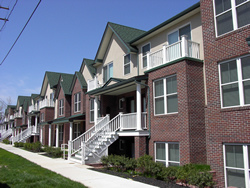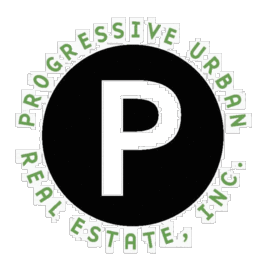
From the Wall Street Journal feature article "Artists vs. Blight", written by Alexandra Alter:
Last month, artists Michael Di Liberto and Sunia Boneham moved into a two-story, three-bedroom house in Cleveland's Collinwood neighborhood, where about 220 homes out of 5,000 sit vacant and boarded up. They lined their walls with Ms. Boneham's large, neon-hued canvases, turned a spare bedroom into a graphic-design studio and made the attic a rehearsal space for their band, Arte Povera.
The couple used to live in New York, but they were drawn to Cleveland by cheap rent and the creative possibilities of a city in transition. "It seemed real alive and cool," said Mr. Di Liberto.
Their new house is one of nine previously foreclosed properties that a local community development corporation bought, some for as little as a few thousand dollars. The group aims to create a 10-block "artists village" in Collinwood, with residences for artists like Mr. Di Liberto, 31 years old, and Ms. Boneham, 34.
Artists have long been leaders of an urban vanguard that colonizes blighted areas. Now, the current housing crisis has created a new class of urban pioneer. Nationwide, home foreclosure proceedings increased 81% in 2008 from the previous year, rising to 2.3 million, according to California-based foreclosure listing firm RealtyTrac. Homes in hard-hit cities such as Detroit and Cleveland are selling for as little as $1.
Drawn by available spaces and cheap rents, artists are filling in some of the neighborhoods being emptied by foreclosures. City officials and community groups seeking ways to stop the rash of vacancies are offering them incentives to move in, from low rents and mortgages to creative control over renovation projects.
"Artists have become the occupiers of last resort," said Robert McNulty, president of Partners for Livable Communities, a Washington-based nonprofit organization. "The worse things get, the more creative you have to become."
Artists and architects are buying foreclosed homes in Detroit for as little as $100. In St. Louis, artists are moving into vacant retail spaces in a shopping mall, turning stores that stood empty for more than a year into studios and event spaces for rents of $100 a month. Artspace Projects Inc., a national nonprofit development corporation, plans to create 35 live/work spaces for artists on vacant property in Hamilton, Ohio, after converting an empty car factory and an adjacent lot in Buffalo, N.Y., into 60 artists' lofts last year.
In neighborhoods pocked by vacancies, artists have started filling the void. Last November, Katherine Chilcote, a local painter, bought a boarded-up, bank-owned house for $5,000 in Cleveland's Detroit-Shoreway neighborhood, where one in four family homes has gone into foreclosure in the last three years. Thieves had stolen the doors, punched out windows and ripped out all the pipes, sinks and electrical wiring. Eight cats had moved in.
The 29-year-old artist and four friends spent months ripping up moldy carpet, laying down new tiles and hardwood floors, repairing walls and stripping peeling paint. She bought the empty, weed-filled lot next door for $500. She plans to build a sculpture garden there, with large, whimsical mobiles that twist in the breeze. She's applying for grant money from the Cleveland Foundation to turn four more vacant houses in the neighborhood into artist residences and studios.
Through her nonprofit public art organization, Building Bridges, Ms. Chilcote is also working to turn vacant storefronts in Cleveland's Westown neighborhood into artists' exhibition spaces. Four storefronts are now filled with hand-painted pottery, landscapes of trees and fields, and large, spray-painted scenes of the city's abandoned steel mills and factories.
Ms. Chilcote plans to expand to seven storefronts this summer, and is working with the Westown Community Development Corp. to create nine permanent artist residences and studios in an old theater that's been vacant since the mid-1980s. In the meantime, Ms. Chilcote and other artists are hatching creative, temporary uses for buildings that are scheduled to be demolished. This summer, she plans to transform an empty ice cream parlor into a giant sculpture of a cake.
What began as a grass-roots movement, with artists gravitating to cheaper neighborhoods and making improvements, is now being embraced by city officials as a tool to revive neighborhoods reeling from vacancies and home foreclosures.
Over the next 18 months, Cleveland plans to spend $500,000 to fund 50 citizen-led pilot projects to reclaim vacant property. The Cleveland Urban Design Collaborative, part of Kent State University's College of Architecture, launched an initiative called "Pop Up City" a year and a half ago, which brings performance artists into empty lots, vacant buildings and unused urban infrastructure. In Cleveland's Detroit-Shoreway neighborhood, two theater companies have teamed with the local development organization on a $30 million drive to rebrand the former factory hub as an entertainment and arts district, with a new community theater and independent-film house.
"At first, the strategy was [placing artists in] old warehouses, now it's whole neighborhoods," says Bob Brown, director of the Cleveland City Planning Commission. "The next phase is capitalizing on the presence of artist and art-related businesses and using it as the lever for high-density development."
This September, Cleveland's Community Partnership for Arts and Culture will host its second conference, titled "From Rust Belt to Artist Belt," with artists, city leaders, local banks and real-estate agents to discuss ways to transform Cleveland into a regional arts hub. Tom Schorgl, the group's president, said it's creating a Web site for artists that will include a searchable database of cheap properties. His group is also helping artists find vacant properties through the newly created county land bank -- a bank of distressed properties the county will manage until they can be redeveloped.
Artists have flocked to, and improved, blighted areas for decades -- for example, New York's SoHo and Williamsburg, parts of Baltimore and Berlin, Germany. They often get displaced once gentrification begins. But now, since real estate has hit rock bottom in many places, artists with little equity and sometimes spotty credit history have a chance to become stakeholders, economists and urban planners say.
Cleveland's push is modeled in part on an arts-fueled revival in Paducah, Ky., Mr. Schorgl said. Paducah transformed a rundown, crime-ridden neighborhood into an arts district by offering artists from around the country a $2,500 reimbursement to buy cheap, vacant houses and fix them up. Some artists bought homes for $1 when the program launched in 2001. Since then, more than 50 artists have moved into the neighborhood, which is now dense with cafes, wine bars and art galleries.
The strategy is controversial. Some urban planners warn against treating the arts as a cure-all for urban development, particularly since low-income residents are often forced out when artists move in. "Artists have had the effect of gentrifying neighborhoods that were working for the existing communities," says Dana Cuff, an architecture professor at UCLA and founder of cityLAB, an urban-design think tank.
Some artists are also wary of being branded as agents of development. "I could never afford the neighborhoods that I've helped contribute to," says Bridget Ginley, a 38-year-old painter, who says she was priced out of Cleveland's trendy Tremont and Ohio City neighborhoods once the galleries and restaurants arrived.
In Collinwood, where Mr. Di Liberto and Ms. Boneham moved last month, the Northeast Shores Development Corp. has bought nine vacant properties, and so far has renovated five as artists' residences. Executive director Brian Friedman says the group plans to expand the project to 25 or 30 homes, using funds from the U.S. Department of Housing and Urban Development's $4 billion Neighborhood Stabilization Program.
In exchange for low rents or low-interest mortgages that range from $500 to $1,100 a month, the artists help design the homes. Artists also have the option of buying the homes cheaply and fixing them up themselves. The development corporation verifies potential home-buyers' income and ability to pay rent, and asks artists to specify in their housing application what type of creative work they do, and what kind of work space they want.
Mr. Di Liberto and Ms. Boneham, who first moved to Cleveland from New York in 2006, pay $595 a month in rent in their new house. After they make monthly payments for a year, the rent will roll over into a fixed mortgage towards the house's $104,000 cost. Three of the couple's friends, fellow artists and musicians, are now looking to buy foreclosed houses in the neighborhood.
"Our chief goal is ownership," says Mr. Friedman. "We don't want the neighborhood to gentrify them out."
Once a bustling neighborhood of Eastern European rail workers, Collinwood now has a 40% poverty rate. A few years ago, its commercial strip, Waterloo Road, had little more than two dive bars and a flophouse where drug dealers and prostitutes lived. Home prices have plummeted to $18,000 today from a median of $68,000 before the foreclosure crisis.
The seeds of the renaissance were planted by a dozen artists who formed a collective called Arts Collinwood. Five years ago, the group bought the 5,000-square-foot flophouse with donated money and began converting it into an art gallery, café and nine art studios that rent for $150 a month. Arts Collinwood, now a non-profit directed by neighborhood resident Sarah Gyorki, paved the way for a flood of musicians, painters and sculptors. In the last couple of years, three other art galleries, a recording studio, vintage record store, boutique and a stained glass studio have opened on Waterloo.
These cultural outposts sit alongside traces of the old neighborhood: two shops that sell handmade sausages, and a Slovenian Hall where neighborhood residents gather for Friday fish fries, polka music and bocce.
The transition hasn't been completely smooth. Jim Tomko, one of the first to open a gallery on Waterloo, closed it last year after someone broke in and stole about $8,000 worth of paintings. Undercover police officers caught the thief, a neighborhood resident who was selling the paintings out of his nearby home for $20 a piece.
A few blocks over, on a street dotted with boarded-up houses, Monica Doyle is renovating a foreclosed house that she bought for $7,150. Ms. Doyle, a painter and Cleveland native who moved back to the city from Australia three years ago, bought the house last August. The plumbing had been stolen, the bathroom and kitchen walls had been ripped out, and a family of raccoons was living in the attic. She renovated the top floor, where she now lives and paints, and plans to rent out the ground floor once it's fixed up. "It was like a great canvas itself just to bring this place to life," she says.
Write to Alexandra Alter at alexandra.alter@wsj.com.





